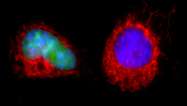Study shows vast majority of cells close to death after toxin exposure can survive and thrive

(Phys.org) -- The vast majority of cells that appear to be on a one-way track to death after exposure to toxins can bounce back completely after those toxins are removed, Johns Hopkins scientists report in a new study. The finding, published in the June 15 issue of Molecular Biology of the Cell, is not only a testament to the indomitable cellular spirit, but could also offer some practical insight on how to save dying tissues after heart attacks or strokes as well as prevent cancer in cells transiently exposed to toxins.
For decades, researchers have known that cells undergo a type of programmed death called apoptosis, says study leader Denise Montell, Ph.D., a professor in the Department of Biological Chemistry at the Johns Hopkins University School of Medicine. Apoptosis can be both positive and negative, she adds. For example, cell death is absolutely necessary to sculpt fingers from paddle-shaped hands during development and to kill off rogue cells that could be the start of cancerous tumors. However, it also kills cells in excess after traumatic events such as a heart attack or stroke, or in degenerative diseases such as Alzheimer’s.
When apoptosis was first described long ago, Montell explains, researchers explained it as a series of physical changes that cells undergo, including the cell edges developing irregular bulges, called blebs. More recently, gene expression data has shown that certain proteins appear and others disappear when cells are dying. But even with these signs, Montell says, it’s been unclear when cell death is irreversible.
“There’s clearly some point when something is truly dead and can’t come back,” she says, “but there’s been a controversy about what constitutes the point of no return for cells.”
To find out, Montell, postdoctoral fellow Ho Lam Tang and their colleagues exposed healthy mouse liver cells growing in petri dishes to ethanol, a toxin. Within hours, the cells displayed the typical hallmarks of apoptosis, including cell body and nucleus shrinking, cell membrane blebbing and an altered appearance of cellular organelles. However, when the researchers washed the ethanol away, they watched in amazement as many of the cells plumped back up, smoothed their membranes and regained normal organelles. Montell points out that it’s not the rare “escaper” cell that turned back from death — about 90 percent of the cells exposed to ethanol managed to survive.
“You can watch an individual cell shrivel up, look like it has no chance and then come back to life,” she says.
The findings held true for a variety of cell types, Montell adds, including mouse brain and rat heart cells. This suggests that the ability to defy death could be universal for all or at least many kinds of cells in the body, she says. Additionally, the team discovered that reversing apoptosis wasn’t just something physical to observe in the microscope. Gene expression data showed that several molecular indicators that researchers had considered signs of imminent death, such as the appearance of the activated form of an enzyme known as caspase-3, also reversed when cells sprang back to life.
Though part of the apoptosis program includes cells chopping up their own DNA —part of a complicated self-destruction sequence — further tests showed that they could snap back even from this drastic genetic damage, stitching the severed pieces back together. However, Montell notes, she and her team found that sometimes cells made mistakes, missing pieces of DNA or stitching the wrong pieces back together. Since these errors can lead to cancer, she and her colleagues tested whether surviving cells exposed to toxins had malignant characteristics. Sure enough, they found that a small percentage of the cells grew abnormally, developing some hallmarks of cancer.
The findings could have implications for explaining and treating cancer, as well as a variety of other diseases, Montell says. For example, though researchers know that alcoholics have a propensity toward developing liver cancer, the reasons have been unclear. Based on her team’s findings, it’s possible that they might continually be bringing their liver cells toward the brink of death and that some surviving cells continue on with genetic defects that lead to malignancy, she explains.
The results might also explain why cancer cells often develop resistance to chemotherapy. During chemotherapy, cells are transiently exposed to toxic drugs that induce apoptosis, and then the patient is allowed to recover, so while most of the cancer cells die, those that survive may develop genetic defects that contribute to their ability to survive the next round.
Montell and her team plan to continue to investigate the mechanisms behind this ability to bounce back, which they’ve named anastasis — a Greek word that means “rising to life,” the opposite of apoptosis, which means “falling to death.” Knowing more about this process could eventually lead to ways to enhance it, Montell says, which could be a boon for conditions in which apoptosis occurs to excess. On the other hand, identifying ways to reduce or prevent anastasis could be useful for preventing the development of resistance to chemotherapy or other conditions where cell survival is harmful.
More information: This research was supported by a Fulbright Grant, Sir Edward Youde Memorial Fellowships, Dr. Walter Szeto Memorial Scholarship, National Institutes of Health/National Institute of General Medical Sciences grant (R01GM46425), the University Grants Committee of the Hong Kong Special Administrative Region, China (Project No. AoE/B-07/99), Lee Hysan Foundation and Lo Kwee-Seong Biomedical Research Endowment Fund.
Journal information: Molecular Biology of the Cell
Provided by Johns Hopkins University
















